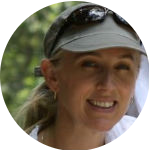-
Member Login
- Home
- About
- Institute Groups
- Membership
- Events
- News & Publications
- Institute Programs
- Resources
- Jobs Board
- Contact Us
- Site Info
Celebrating women in the environment
This International Women's Day, we are shining a spotlight on some of the wonderful women working in the environment sector. Like a lot of our members, they share a passion for the environment and a desire to make a difference, but they all have unique experiences and stories to tell.
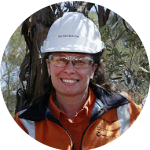
Belinda Bastow MEIANZ
Belinda joined EIANZ in 2014. She is currently Acting President of the Western Australian Division.
What do you do?
I own and operate an environmental / safety / land access consultancy assisting companies meet their environmental obligations
What inspired you to pursue a career in the environment sector?
I choose to study and work in the environmental sector because I wanted to ensure our beautiful planet was protected and to minimise impacts from development. I understand that development and day to day use of our natural resources must occur, so I felt that it was important to be part of the solution.
What do you find most rewarding about a career in the environment sector?
I fined helping people see the environment that exists around them and understand that development can occur in a way that can prevent or minimise environmental impacts rewarding.
What has been the biggest challenge you have faced in your career and how did you overcome it?
Starting up my own company after spending over 20 years working for resources companies as an environmental professional was a challenge. It took a while to realise that my skills and experiences are valuable and are of interest to others. In the end, it was my professional network, the support of my husband and talking to other professional who had set up their own companies that has helped me get to where I am now two years on.
What is your biggest environment concern?
Unsustainable land clearing, waste generation and human induced species extinction
Where do you think the environment sector is headed / What are your thoughts on the future of the environment sector?
I think environmental professional needs to stand-up for the environment and challenge the poor decisions being made by government under the banner of economic growth. We can have a strong economy without sacrificing the environment. I am concerned that our sector is still seen as a cost to companies and industry rather than a way to help business be truly sustainable and able to reduce costs. As a member of EIANZ, and more generally an environmental practitioner, we need to actively promote our profession and regularly challenge ourselves and business to reduce their environmental impacts.
Dr Kerry Beggs MEIANZ
Kerry has been a member since 2012. She is the Treasurer of the Far North Queensland Division.
What do you do?
I am an independent consultant trading as ‘EnviroBiometry’. I specialise in the analysis of environmental monitoring data, but also do project management for land management programs, ecological assessments, environmental management plans and identification of aquatic macroinvertebrates. I have a keen interest in environmental education and do some voluntary work with a sustainability group at my children’s school – hoping to help inspire the next generation to look after our environment!
What inspired you to pursue a career in the environment sector?
I have always loved nature – plants, animals, bushwalking and camping - so from a young age I knew I wanted some kind of career in science that meant interacting with nature. However, I started university with the aim of becoming a palaeontologist, but only did one year and then firmly decided I wanted to help look after what is here now, not learn about or dig up the past. I did a Bachelor of Applied Science specialising in ecology and loved the hands-on work doing field studies and learning to identify various creatures.
What do you find most rewarding about a career in the environment sector?
What I find most rewarding is that I truly feel like I am contributing in small ways, in my region, to look after the environment. Whether is it helping a client understand and mitigate risks their activities may have on the environment, or overseeing land management work such as weed control, or running analyses to see if a vegetation rehabilitation program is working – I feel like the work is meaningful and important.
What has been the biggest challenge you have faced in your career and how did you overcome it?
The biggest challenge has been juggling my career with having a family! The first 10 years or so I was working mostly in ecological research, and spent lots of time out bush, which was fantastic. I realised that working as a field ecologist wasn’t too compatible with being the kind of mum I wanted to be, so started thinking about other options. I always wanted to work for myself but the irregular income seemed too big a hurdle when my children were very young and I had to pay for childcare, so I opted for salary work instead. I spent about 3 years’ working full-time in a salaried position (while doing a bit of private consulting in my ‘spare time’), and didn’t enjoy how little time I had for my family. As fate would have it, I was made redundant in 2014, so took the plunge and returned to Plan A and 100% self-employed. The desire for greater flexibility in my working hours was the main driver for setting up my own consultancy. I still struggle with achieving a good work-life balance, and I work more hours each week now than when I was an employee, but it is more rewarding as I am reaping the financial benefits for my hard work. I love being my own boss.
What is your biggest environment concern?
If I had to choose just one, I would have to say climate change, because of the widespread nature of the impacts. Feeding into this, our continued reliance on coal and other non-renewable energy. I would like to see more action at the highest levels to try and turn things around.
Where do you think the environment sector is headed / What are your thoughts on the future of the environment sector?
Depending on the government of the day, environmental protection seems to move up and down in the list of priorities! I hope that small changes, such as CEnvP being incorporated in QLD planning documentation, will drive demand for high quality environmental scientists. The current economic situation has led to a downturn in mining and construction activities in many areas, which has resulted in fewer jobs in the environment sector. I think this has led to a greater demand for environmental professionals to have skills across multiple fields, as companies may only employ a few staff, when once they may have had several, each with a different specialist skill set. Not exactly sure where things are headed, but I can only hope the economy turns around and our sector sees growth as well.
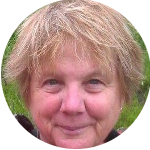
Carolyn Cameron MEIANZ
Carolyn joined EIANZ last year and quickly took on the role of President for the ACT Division.
What do you do?
Currently, after 30 plus years in government and academia, I have established a consultancy called Cameron Strategies. My main clients are government departments, the Great Barrier Reef Marine Park Authority and Jacobs. I basically draft policies, guidelines, provide strategic advice and facilitate high-level stakeholder engagement. For example, the Jacobs’ work has focused on developing scenarios and ideas for coordinating mine rehabilitation in the Latrobe Valley for the Victorian Government.
What inspired you to pursue a career in the environment sector?
I recognised that traditional disciplines were not capable of providing appropriate answers for the emerging problems the world was facing and signed up for one of the first interdisciplinary Master’s courses in environmental science at Miami University in Ohio USA. Here I read The Tragedy of the Commons by Garret Hardin and was hooked forever on trying to make a difference.
What do you find most rewarding about a career in the environment sector?
People care; they are passionate and it is usually more about channelling the energy rather than trying to whip up enthusiasm.
What has been the biggest challenge you have faced in your career and how did you overcome it?
Leading a delegation from the Australian Government to talk to technical experts at the IUCN in Geneva and World Heritage Centre in Paris about how we were undertaking a strategic environmental assessment of the Great Barrier Reef. It sounds romantic and exciting, but there was so much riding on getting the correct messages across, the team and I were extremely anxious. The delegation consisted of four inter-departmental and inter-governmental technical experts. We addressed our concerns and got over our nerves by rehearsing our presentations and taking on board each other’s suggestions. The message here was never be too self-important to be part of a team.
What is your biggest environment concern?
Like many concerned colleagues, especially those of us with grandchildren, climate change
Where do you think the environment sector is headed / What are your thoughts on the future of the environment sector?
The environmental sector is a bit like Ian Lowe’s fried egg diagram of sustainability. For those of you who don’t know it: imagine 3 circles; ecology is the largest on the bottom, with society next and the economy as the third top layer, totally dependant on the other two layers. We are certainly in ‘curious’ (as Alice would say) times geopolitically. With our knowledge and understanding of the ecosystems we depend on, we must continue to speak the truth and look for opportunities to show others how to facilitate alternative, more sustainable futures.
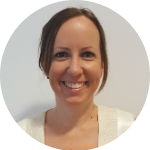
Tara Horsnell MEIANZ
Tara is a member for the Victorian Division Committee and first joined EIANZ in 2010.
What do you do?
I am a Senior Impact Assessor at the Department of Environment, Land, Water and Planning in Victoria.
What inspired you to pursue a career in the environment sector?
I have always loved the natural environment and felt a strong passion for environmental protection from an early age.
What do you find most rewarding about a career in the environment sector?
I like the diversity of work that you get exposed to by working in the environment sector (i.e. marine ecology, air quality, hydrogeology etc.) and the ability to work across different industries as an environmental professional. Knowing that my work helps to achieve a better environmental outcome is the most rewarding aspect for me.
What has been the biggest challenge you have faced in your career and how did you overcome it?
A challenge in the past was trying to influence decisions without authority. I got better at this by making sure I thoroughly prepared ahead of meetings, including thinking of all the possible challenges and questions I would face, and thinking about how I could best answer them.
What is your biggest environment concern?
Climate Change - and the myriad of effects it will have on the marine environment, species, ecology, water scarcity etc.
Where do you think the environment sector is headed / What are your thoughts on the future of the environment sector?
I think the environment sector will grow as peoples' awareness of issues such as climate change increases. As a sub-sector, sustainability has grown rapidly in recent years and I think it will continue to, along with energy efficiency and climate change adaptation.
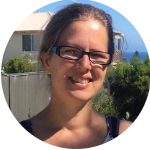
Joanna Hugues-dit-Ciles MEIANZ
Joanna is part of the Western Australian Division and became a member last year.
What do you do?
Since 2005, I have worked as a program manager for South West Catchments Council, a Regional NRM body in Western Australia with a 3-year period managing a sub-catchment group called Leschenault Catchment Council. In that time, I have managed regional water, marine, coastal, and biodiversity programs and projects and worked with multiple stakeholders.
What inspired you to pursue a career in the environment sector?
I grew up in the Jura mountains in eastern France, on the Swiss border, in a small village (of less than 60 people) with incredible surroundings including semi pristine forests, fields, lakes, rivers and waterfalls which were my backyard. I spent my free time making hay bales and feeding the dairy cows, saving native fish from one of the rivers during its annual summer drought, hunting for wild culinary mushrooms as well as raspberries and blackberry picking with the villagers to make jam for the year. Encounters with wildlife including red robins, king fishers, deers, hedgehogs, squirrels, pine martins, foxes and birds of prey were all part of my everyday life. During my teens, I quickly realised that what I was accustomed to was not the norm and that elsewhere in France, and around the world, the picture was not so rosy. Back then, WWF used to do many campaigns to protect the rainforest in South America and this triggered my interest in wanting to work towards protecting the environment. After high school, I spent one year in business studies in Lyon in France, which provided little insight into sustainable business development in a world of dwindling and limited resources. This renewed my interest in having an active career in the environment, so I left for England where I went to study a BsC in Wildlife Conservation. I had then the great fortune to work for the World Conservation Monitoring Centre (WCMC- UNEP) in Cambridge as a marine researcher during my placement year during my degree which opened my eyes to the varied work that was taking place globally. I was also fortunate to work for an inspiring woman, Professor Helen Marsh, who gave me an opportunity to work with her at JCU in Queensland to co-author a book on Dugongs for IUCN. From then, I knew that if I put enough energy into something, I could work towards making a difference.
What do you find most rewarding about a career in the environment sector?
It is empowering to see and look back at restoration projects and witness the tangible environmental outcomes such as seeing seedlings growing into healthy trees and shrubs, riparian areas being restored and native wildlife returning to areas. Having had the opportunity to design projects where the community has been actively involved and part of the journey provides me with a great sense of reward when the collective enjoys, treasures and take pride preserving and conserving unique assets surrounding them.
What has been the biggest challenge you have faced in your career and how did you overcome it?
Moving from Canada/Europe to Australia for work was both the most exciting and challenging times in my career as I had to get familiar very quickly with the unique biodiversity and vegetation. The environment here was mind blowing, foreign and the learning curve was steep. Learning to grasp the basic concepts of Australian plant ecology remains the biggest challenge. Getting support from the tight-knit environment community and my peers’ passion and their intricate knowledge has been an ongoing source of information to quickly learn from. I am also motivated to work in collaboration with others to obtain the best environmental outcomes.
What is your biggest environment concern?
My biggest concern is the unprecedented growing world population and its continuous demand on ecosystems, species, habitat clearing and loss of biodiversity, all this coupled with the impact of climate change. The carrying capacity of the planet is so finite and unfortunately the continuous and insatiable demand for higher living standards, the expectation of being able to continuously buy new things that are quickly discarded and replaced for the next best thing is a scary prospect.
Where do you think the environment sector is headed / What are your thoughts on the future of the environment sector?
The environment sector is entering a time of competing agendas both nationally and globally. The key force to see change is to empower the general public and ensure that as consumers and global citizens, each and every one of us has the capacity to make choices in our daily lives that can make a difference on the environment and future generations. As scientists thus, our role is to ensure that we share and communicate information and foster a sense of empowerment into becoming citizens of change.
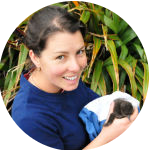
Tessa Roberts MEIANZ
Tessa is member of the New Zealand Chapter and became a member last year.
What do you do?
I am an ecologist who works with a team of ecologists for Boffa Miskell Ltd, an environmental consultancy company based in Wellington. I work with a range of private and government agencies, basically to ensure the Resource Management Act and conditions of consent are adhered to in situations where an activity has the potential to impact the environment. This includes writing impact assessments, restoration and management plans and implementing these documents on the ground.
What inspired you to pursue a career in the environment sector?
The grandfather of ecology himself! I read the essay, A Sand County Almanac by Aldo Leopold in my first year of university while doing general science.
What do you find most rewarding about a career in the environment sector?
Finding solutions to sometimes unique and challenging problems. Also, just being outside a lot, and the diversity in working with a range of people, disciplines and environments.
What has been the biggest challenge you have faced in your career and how did you overcome it?
I guess having the confidence to believe in yourself, your knowledge and stand by your decisions. Experience and surrounding yourself with supportive people who you can discuss issues and ideas without bias or judgement helps with overcoming this, but I think it will be something I will always be improving on.
What is your biggest environment concern?
Unsustainability - ultimate cause of all subsets of environmental concern.
Where do you think the environment sector is headed / What are your thoughts on the future of the environment sector?
I'm hoping this post-truth business is a fad! However, in light of the current situation I think science will need to be a lot more multi-disciplinary, inclusive and communicative heading into the future.
EIANZ membership
EIANZ operates across all states and territories in Australia and throughout New Zealand, embracing all disciplines of environmental practice. Currently, 40 per cent of our members are females. Over the last 6 years, there has been a slight increase in the ratio of female members.
The graph below shows gender distribution by Division / Chapter (as at 7/03/2017).
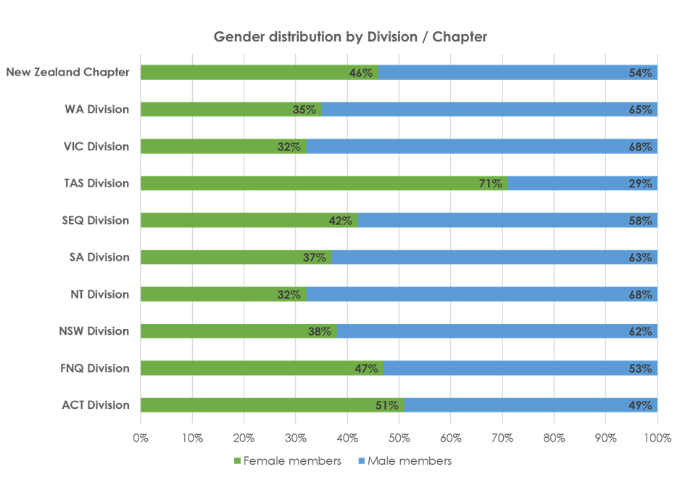
Join us!
No matter what your experience, professional recognition and support can be exceptionally valuable when dealing with the complexities of environmental practice. As an EIANZ member, you are part of a supportive, professional community contributing to the development and implementation of good practice environmental management by government, industry and the community.
We acknowledge and value the rights and interests of Indigenous Peoples in the protection and management of environmental values through their involvement in decisions and processes, and the application of traditional Indigenous knowledge.


